
Catalog excerpts

TopMap Success stories Applications of 3D surface metrology
Open the catalog to page 1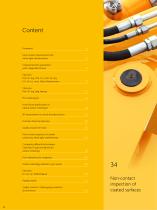
Content Foreword Areal surface measurement with white-light interferometry Characterize form parameters with a large field of view Interview Prof. Dr.-Ing. Prof. h.c. mult. Dr.-Ing. E.h. Dr. h.c. mult. Albert Weckenmann Interview Prof. Dr.-Ing. Jörg Seewig The smoking gun How fair are specifications in optical surface metrology? 3D measurement on shock absorber pistons Function driven by precision Quality around the clock Non-contact inspection of coated surfaces by white-light interferometry Comparing different technologies Overview of optical methods for surface metrology Form deviation...
Open the catalog to page 2
Surface metrology tailored to your needs TopMap family 38 Comparing different technologies
Open the catalog to page 3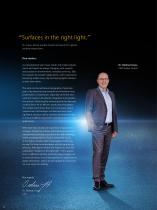
“ urfaces in the right light.” S Dr. Gnass about market trends and need for optical surface inspections Dear readers, our development team never stands still; market requirements and needs are always changing, with research and production environments constantly evolving. Take for example microsystem applications, with components becoming smaller every day and having tighter tolerances than ever before. The same can be said about topography of precision parts, they become more complex and therefore more problematic to characterize, especially when the measurement needs to be directly...
Open the catalog to page 4
precision measurement systems that quickly scan the topography of white-light interferometry a workpiece. Well-established white-light interferometry achieves a resolution at the nanometer scale. Why measure with light?Why measure with TopMap white-light interferometers? ■ Non-contact, non-destructive and repeatable surface characterization ■ Full areal information in 3D to capture all surface details ■ On almost any surface ■ Excellent lateral resolution ■ Check manufacturing tolerances in a short time ■ Large field of view even without stitching ■ Objective-free design avoids risk of...
Open the catalog to page 5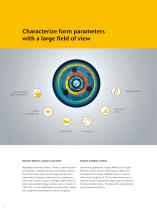
Characterize form parameters with a large field of view LARGE AREAL MEASUREMENT HEIGHT & STEPS FORM PARAMETER Measure flatness, waviness and more Regarding functional surfaces, flatness is often decisively important. Examples are parts with sealing surfaces for pressure and vacuum technology, and also transparent foils for displays, semiconductor components, metal and ceramics surfaces. TopMap systems allow an areal measurement of large surfaces up to a volume of 230 x 220 x 70 mm³ and therefor provide a fast, reliable and complete characterization of your workpiece. Analyze multiple...
Open the catalog to page 6
Characterize structures with high resolution STRUCTURAL DETAILS FILM THICKNESS Characterize microstructures Evaluate roughness Functional surfaces often require certain structures. For example, it can be important to characterize the type and distribution of pores used to hold lubricant between frictional surfaces in tribology. Besides, microstructres show a key role for improving the adhesion of coatings in the steel industry. Unwanted structures may increase frictional forces or cause disturbing vibrations. Characterization of roughness is a must-do, particularly when wear properties,...
Open the catalog to page 7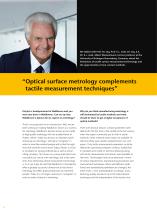
We talked with Prof. Dr.-Ing. Prof. h.c. mult. Dr.-Ing. E.h. Dr. h.c. mult. Albert Weckenmann, former professor at the University of Erlangen-Nuremberg, Germany, about the limitations of tactile surface measurement technology and the opportunities of non-contact methods. “ ptical surface metrology complements O tactile measurement techniques” Polytec is headquartered in Waldbronn and you were also born in Waldbronn. Can we say that Waldbronn is famous for its experts in metrology? That’s a nice question for an introduction. Well, we are both working on making Waldbronn known as a nucleus...
Open the catalog to page 8
keep pace with – the development. Almost all of the people involved in specifying, manufacturing and quality assurance, such as operators, technicians and engineers, must be retrained, and the question arises whether the "old" technical drawings are still valid. So there are some very good reasons why people involved with production measurement technology have very conservative attitudes. Optical methods are therefore being introduced very tentatively into surface measurement technology. The acceptance can be accelerated only moderately through measures that are aimed at conviction and...
Open the catalog to page 9
to replace tactile measurement technology. In areas where this technology is established, it will continue to be applied. It makes more sense to use the many fold advantages of the optical data acquisition for new applications and to extend the computerized evaluation in such a way that the degree of the expected functionality can be predicted. There are different optical methods for characterizing surfaces. Each one has its advantages and limitations. The end-user wants to see results, or in other words his or her aim is to characterize the product or process based on the measurement...
Open the catalog to page 10
effort can be minimized. There is only a need to measure what will be processed further, required for documentation or necessary in the event that there are complaints or liability claims. Costs can be saved if nothing will be done with the measurement results! Although the level of available information about products in micro- and nanometer dimensions is in reasing (thanks to optical c methods), industry is still trying to solve problems with macro-dimensional methods. You are an expert for GPS (geometrical product specifications) so what can you say about the future of GPS for this new...
Open the catalog to page 11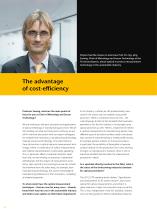
Polytec had the chance to interview Prof. Dr.-Ing. Jörg Seewig, Chair of Metrology and Sensor Technology at the TU Kaiserslautern, about optical in-process measurement technology in the automobile industry. Professor Seewig, what are the main points of focus for you as Chair of Metrology and Sensor Technology? We are working on the basic principles and applications of optical metrology in manufacturing processes. We are still working out what our focal points will be as we are still in intensive discussions with our expert colleagues, for example from mechanics, manufacturing technology,...
Open the catalog to page 12All Polytec catalogs and technical brochures
-
PolyXpert Services
8 Pages
-
Vibrometry
8 Pages
-
TopMap family
16 Pages





